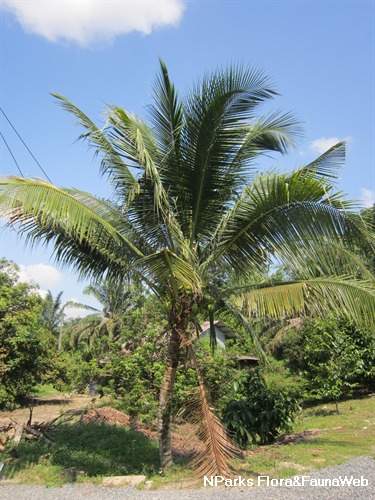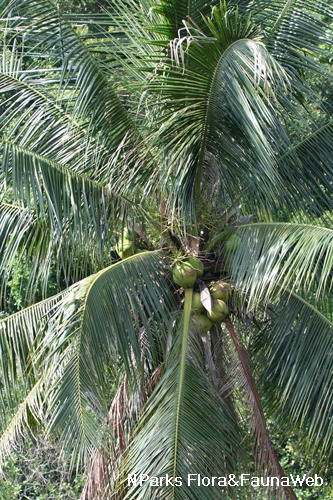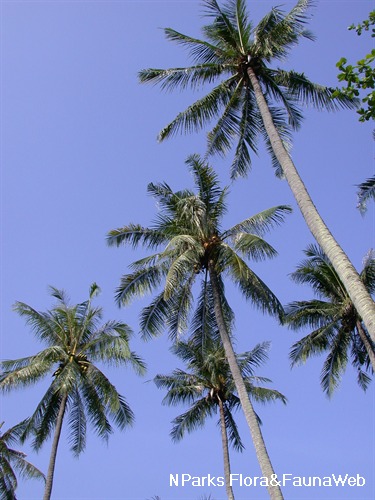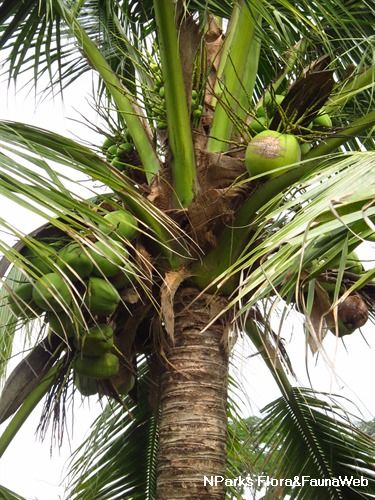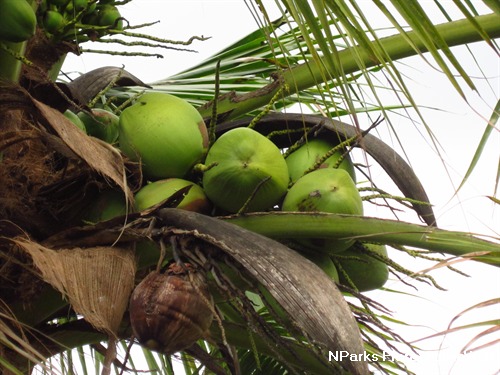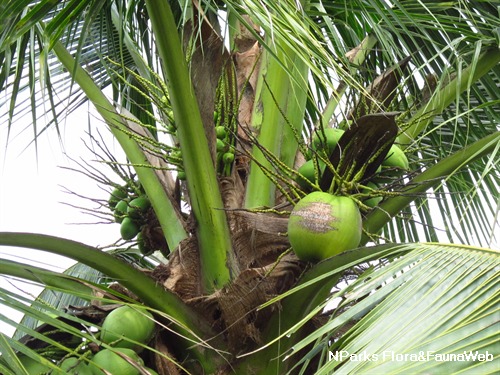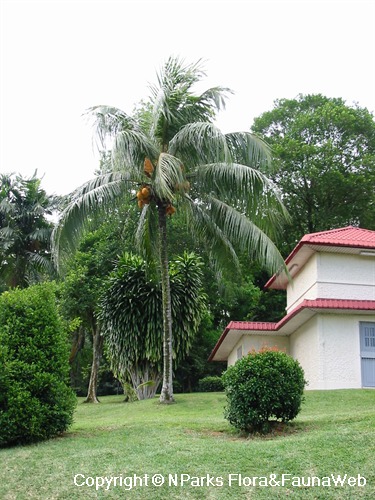
Back
Cocos nucifera L.
| Family Name: | Arecaceae (Palmae) |
| Synonyms: | Palma cocos, Cocos nana, Cocos indica |
| Common Name: | Coconut, Coconut Palm, Kelapa, Niyor, 椰子, 可可椰子 |
A solitary coastal palm, the Cocos nucifera, or Coconut, is fast-growing and can reach up to 30 m in height. Besides coconut water, known for its refreshing and nutritious qualities, the Coconut’s palm fronds can be plaited into a wrap for the ketupat, a traditional Malay rice cake served during festive occasions.
Name
Classifications and Characteristics
| Plant Division | Angiosperms (Flowering Seed Plants) (Monocotyledon) |
|---|---|
| Plant Growth Form | Palm (Solitary Habit) |
| Mode of Nutrition | Autotrophic |
| Maximum Height | 30 m |
| Maximum Plant Spread / Crown Width | 6 m |
Biogeography
| Native Distribution | Originally Western Pacific, today Pantropical |
|---|
Description and Ethnobotany
| Growth Form | A relatively fast-growing, solitary, slender, unarmed palm which characteristically front the coast in tropical regions and is the allusion of lush, tropical paradises with sandy beaches. |
|---|---|
| Trunk | Stem tall, slender, grey, prominently ringed with old leaf scars (when the leaf die off, it will fall off cleanly from the trunk, leaving a neat rectangular pattern of circular scars). |
| Foliage | Fronds pinnate, large, up to 5 m long, yellowish-green to dark green, ascending to spreading to drooping, bearing 80 to 100 pairs of leaflets that taper to a split tip, with prominently elevated midrib; leaflets simple, lanceolate, 1.5 to 5 cm wide, 50 to 150 cm long. |
| Flowers | Inflorescences spreading, 1.2 to 1.6 m long, cream to yellow, arising from within the lower fronds, consisting of 5 female flowers (with each set between 2 smaller male flowers), enclosed by two bracts (60 to 90 cm long) for protection purposes; inner bract is woody and pointed; male flowers will open about 10 to 20 days to encourage cross-pollination, before the female flowers open. |
| Fruit | Fruits ovoid, up to 30 cm long, ripening from llight green or yellow to brown, consisting of a smooth outer skin (exocarp), a fibrous husk (mesocarp) and a hardy woody shell (endocarp); seed has a narrow, white layer of edible endosperm (flesh) and a large cavity filled with water. |
| Cultivation | Prefers sunny conditions, with sandy medium. Requires moderate watering but soil should be consistently moist. Able to adapt to a wide range of soil types and can tolerate slight acidity and alkaline. Has an unparalleled tolerance to severe coastal conditions. It is also drought tolerant once estalbished.Propagate by seeds. Seedlings could be developed from old nuts if left on the ground (usually the old nuts are used for new plantings). Allow the seedheads to dry on plants then remove and collect the seeds. Sow seeds immediately before they lose viability. Seeds germinate within 4 to 6 months. |
| Etymology | The genus epithet 'Cocos' is derived from the Portuguese for monkey, in an apparent refererence to the facial markings on one end of the nut. Its species epithet 'nucifera' means 'bearing nuts', for its ability to produce coconuts. |
| Ethnobotanical Uses | Food (Fruit or Vegetable): Coconut juice can be drank for thirst quenching and the flesh inside the hard shell can also be eaten. Coconut oil can be extracted from pressing the flesh (copra), shredded to make desiccated coconut and squeezed to obtain coconut milk. Coconut milk can be used as an ingredient for preparing curry and local desserts. It can also be used for manufacturing soap, lubricants, explosives and margarine. The youngest part of the shoot makes a succulent vegetable and is edible. The sap tapped from the inflorescence can be used to make toddy. (Herb or Spice) Timber & Products: Stem is used as timber for construction of houses. Others: The midribs of the leaves can be used for making brooms or it can be cut into short sticks to make skewers for the kitchen and darts for blow-pipes. The leaves are also utilized for roofing thatch and for weaving of baskets. The thick outer husk is a source of fibre which can be used to make doormats, brushes, ropes, carpets. Coconut shell can be made into ladles or buttons or even be used as fuel. The oil from the copra can be used for cooking. The water can be used in culture media for growing of orchid seedlings or in tissue culture. Both the pith of the stem and the husk of the fruit can be made into fibre boards and thermal insulating boards. The remaining residue after extracting the oil can be used as animal feed. |
Landscaping Features
| Landscape Uses | Coastal, Suitable for Roadsides, Beachfront / Shoreline |
|---|
Fauna, Pollination and Dispersal
| Fauna Pollination Dispersal Associated Fauna | Butterfly Host Plant |
|---|
Plant Care and Propagation
| Light Preference | Full Sun |
|---|---|
| Water Preference | Moderate Water |
| Plant Growth Rate | Fast to Moderate |
Foliar
| Mature Foliage Colour(s) | Green |
|---|---|
| Leaf Area Index (LAI) for Green Plot Ratio | 2.5 (Palm - Solitary) |
Non - Foliar and Storage
| Trunk Type (Palm) | Solitary Habit, Aboveground |
|---|
Floral (Angiosperm)
| Flower Colour(s) | Cream / Off-White, Yellow / Golden |
|---|
Fruit, Seed and Spore
| Mature Fruit Colour(s) | Brown, Green, Yellow / Golden |
|---|
Image Repository
Others
| Master ID | 31224 |
|---|---|
| Species ID | 5618 |
| Flora Disclaimer | The information in this website has been compiled from reliable sources, such as reference works on medicinal plants. It is not a substitute for medical advice or treatment and NParks does not purport to provide any medical advice. Readers should always consult his/her physician before using or consuming a plant for medicinal purposes. |

